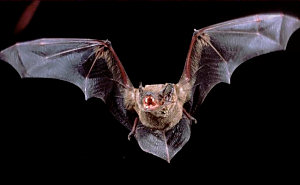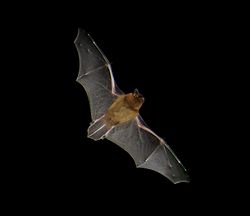
Note: Discoverers events are for families with school age children.
VIRTUAL BAT WATCH
Our “virtual” bat walk took place as planned on Saturday 26th September. We are very grateful to Philip Briggs of the London Bat Group for his efforts in putting together a fascinating talk and “virtual tour”. We are also grateful to those families who have since written to say that they found this event interesting and worthwhile. This was a first for us, and we are grateful for the feedback. We hope many of the families and others will now go on their own bat walks in Richmond Park.
SOME FACTS ABOUT BATS

Common Noctule Bat
Bats must be one of the most misunderstood animals in all Nature! Many people are frightened of them and there are a number of myths and much ignorance about these fascinating and intelligent little creatures.
Because of urbanisation and changes affecting their habitats bats are threatened and endangered, and are now protected in the UK. It is illegal to interfere with their roosts in any way. If you have bats under your roof or in your neighbourhood, consider yourself very fortunate – they will do no harm!
Here are some facts about bats
- Bats are very small. The tiny pipistrelle weighs in at about 4g (try weighing something like blueberries on your kitchen scales to get an idea of what this means) The largest species of bat found in the UK, the noctule, can range from 18-40 gm
- Bats are the only flying mammals. This means they are warm-blooded and suckle their young and usually have one baby a year
- In summer female bats gather together to rear their young in maternity roosts, often in the roof cavities of modern houses
- In towns and cities, bats roost in trees, buildings, and under bridges. They frequently return to the same sites every year
- Bats can live for up to 20 years
- Bats fly and feed in the dark navigating by echolocation. They emit very high-pitched squeaks which bounce off objects around them
- Bats eat insects mainly caught on the wing. A single common pipistrelle can eat up to 3000 insects in one night!

Pipistrelle In Flight
For more information about bats go to
The London Bat Group https://www.londonbats.org.uk/.
The Bat Conservation Trust https://www.bats.org.uk
National Bat Monitoring Programme https://www.bats.org.uk/pages/nbmp.html
WHICH BATS MIGHT WE SEE IN THE PARK?
Nine species are known to occur in the Park. The ones we usually see are soprano pipistrelle, common pipistrelle and Daubenton’s bat.
Pipistrelles
The UK’s smallest bat with a wingspan 19-25 cm. These are bats you are most likely to see in built-up areas, emerging from roosts soon after dusk. There are a number of species – e.g. common, Soprano and Nathusias’ pipistrelle.
Daubenton’s Bat
A medium-sized bat with a wing span of 24-27cm. It is sometimes called the water bat because it swoops in low foraging flights over ponds, lakes, rivers and canals. It mainly roosts in trees.
We may also see the noctule (the UK’s largest bat with a 32-40cm wingspan). They feed in open areas near lakes and rivers. Noctules are thought to be in decline, though they are still widespread in Greater London. Other species found in the Park are Leisler’s bat, Brown long-eared bat and Natterer’s bat. Another – the Serotine- is a rare visitor.
HOW DO WE DETECT AND IDENTIFY BATS IN THE DARK?
The best way is to use a bat detector. Bats emit high frequency calls normally beyond the range of human hearing to build up a sound picture of their surroundings as they hunt insects. A bat detector makes these echo location calls audible to humans, and different bat species make different calls which helps identify them. You will learn how to use a bat detector on the Bat Watch!
For more information contact discoverers@frp.org.uk
To register for this event please complete the following form, including name and age for your children.
BOOKING DEADLINE Sunday 20th September.
Non FRP members are welcome to apply, but in the event we are oversubscribed priority will be given to members.
For details of how to join the Friends of Richmond Park, go to http://www.frp.org.uk/friends/get-involved/
For more information contact discoverers@frp.org.uk

